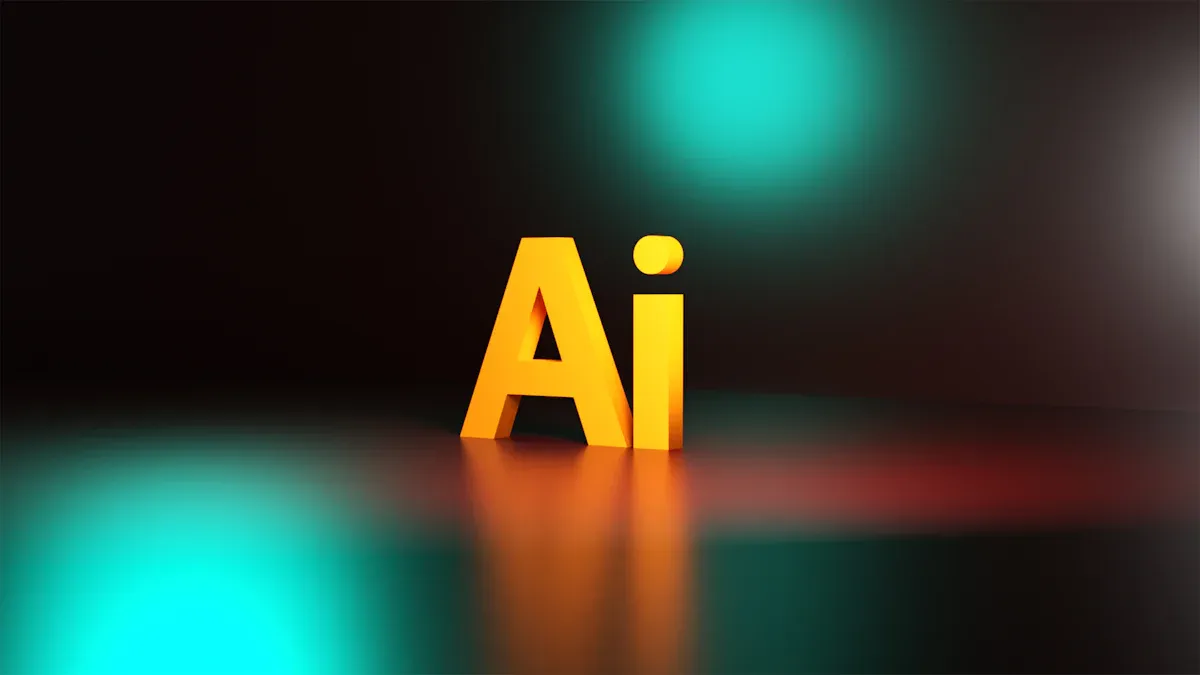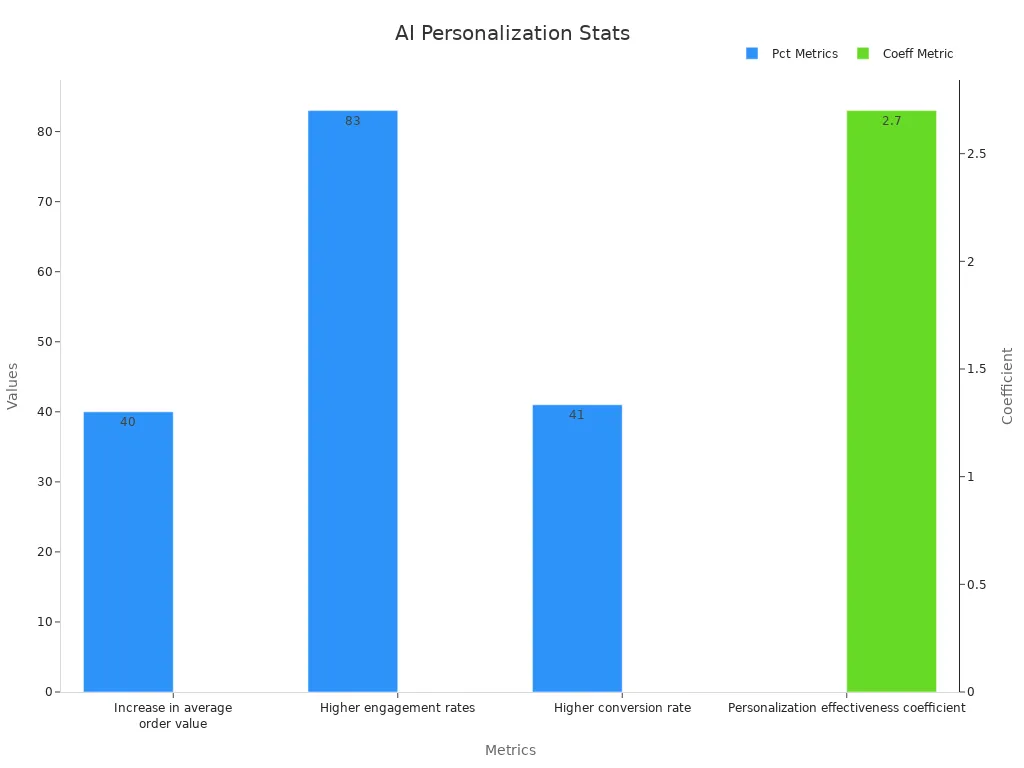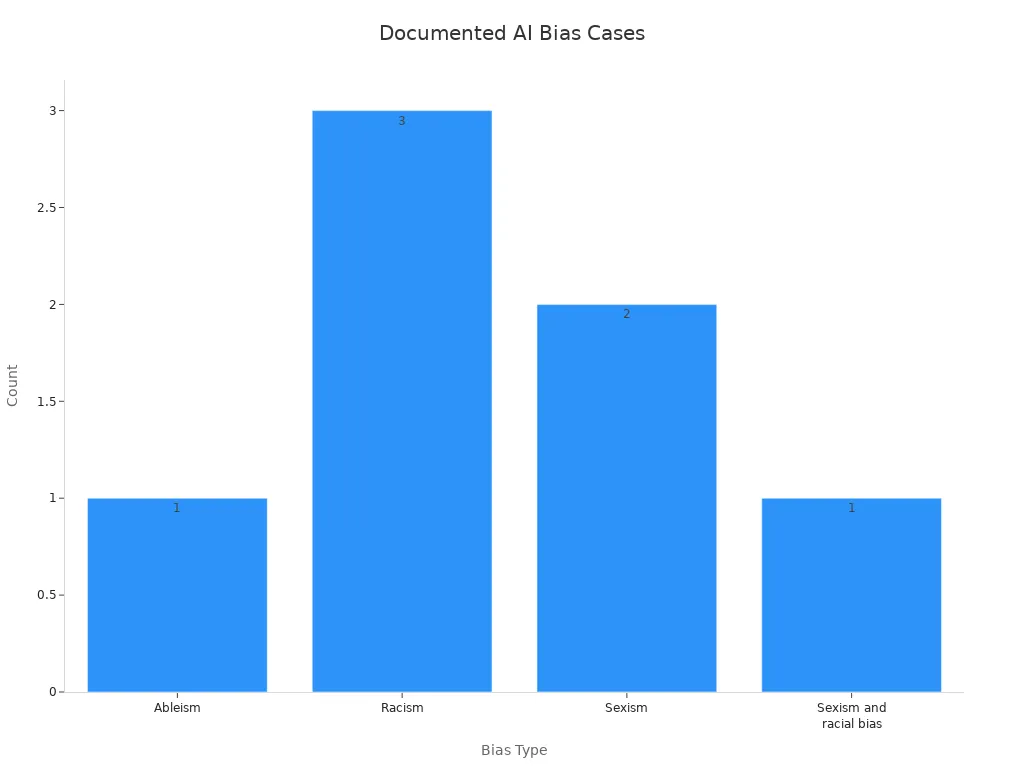The Role of AI in Executive Branding Content

The role of AI has transformed executive branding by providing tools to create a strong image. Companies leveraging the role of AI for advertisements experience a profit increase of 44%. AI-based campaigns achieve 131% more clicks from viewers. These tools assist in crafting custom content that resonates with audiences. Additionally, AI offers instant data to ensure messages remain relevant and up-to-date. In today's competitive market, utilizing the role of AI for branding is not just beneficial—it is essential for maintaining a competitive edge.
Key Takeaways
AI tools help leaders by making custom content that connects with people. This boosts interest and sales.
Using AI to study data helps brands learn what customers like. It also shows trends, keeping them ahead in the market.
AI makes branding tasks easier, saves time, and keeps messages the same everywhere. This builds trust with customers.
AI can check brand performance instantly and show how people feel. This helps brands quickly change their plans if needed.
When AI works with human ideas, branding gets better. AI handles facts, and humans add feelings to connect with others.
Understanding the Role of AI in Executive Branding

What is executive branding with AI?
Executive branding means creating a professional image that matches your goals. With AI, this includes using smart tools like data prediction, language analysis, and learning systems to boost your brand. These tools help you know what people think, predict trends, and make things personal. For example:
Data prediction finds new trends to keep you ahead.
Language analysis studies feedback to improve your message.
Learning systems make content fit what people like.
Using these tools helps you make smart choices. It also builds your image and connects better with your audience.
How AI makes storytelling better for personal branding
Telling stories is key to personal branding, and AI makes it stronger. AI tools find out what people like, so your stories connect more. For example, Coca-Cola uses AI to make ads just for certain people. Small art galleries like Unicorns Young Collectors Club (UYCC) use cool experiences to grab attention.
AI also helps make things personal right away. Websites, emails, and audience plans can change to fit each person. This makes people more interested and shows you understand their needs. It also makes your brand stronger.
Moving from old ways to AI branding
Switching from old branding to AI branding has been huge. Between 2019 and 2023, 76.5% of studies focused on AI branding. Before that, from 1982 to 2013, only 9.1% did.
This change shows how important AI is now. Tools like chatbots, AI insights, and personal content are replacing old methods. They work faster and better. Using AI keeps your branding modern and ready for the digital world.
Applications of AI in Executive Branding
AI-powered content creation for impactful messaging
AI has changed how we make content. It is now faster and smarter. With AI, you can create blogs, social media posts, and video scripts easily. These tools study trends, keywords, and what people like to make better messages. For example, AI can suggest catchy titles or design visuals that match your brand.
AI also keeps your content fresh. It checks real-time data to find popular topics in your field. This helps you share timely and interesting content. Using AI saves time and keeps your messages clear and strong.
Personalization through AI: Reaching diverse audiences effectively
Personalization helps you connect with people, and AI makes it simple. AI tools study user habits, likes, and details to create custom experiences. For example, you can send emails, suggest products, or make ads that fit each person.
AI-driven personalization works really well. It raises average order value by 40% and boosts engagement by 83%. It also improves conversion rates by 41%, making your branding stronger.
Metric | Value |
|---|---|
Increase in average order value | |
Personalization effectiveness coefficient | 2.7 (nearly 3x revenue impact) |
Higher engagement rates | 83% increase |
Higher conversion rate | 41% increase |

Using AI for personalization helps you reach different groups better. This builds trust and loyalty while making your brand stronger.
Real-time brand monitoring and sentiment analysis
AI helps you check your brand's performance instantly. AI tools track mentions, reviews, and social media to see how people feel about your brand. Sentiment analysis shows customer emotions and opinions.
For example, tracking feelings in real time shows if people like or dislike your campaign. Positive scores mean your plan works, while negative ones show what to fix. This quick feedback helps you improve fast and stay on track.
Here are some things AI can help you measure:
Brand Awareness: Shows how many people know your brand.
Social Media Engagement: Tracks likes, shares, and comments to see interest.
Sentiment Analysis: Tells you how customers feel about your brand.
Customer Retention Rates: Checks how many customers stay with you.
Net Promoter Score: Measures if customers will recommend your brand.
Adding sentiment analysis to your plan helps you react to feedback. This improves your brand's image and builds a stronger bond with your audience.
Data-driven decision-making for strategic branding.
Using data for decisions changes how branding works. AI tools help study large amounts of information to find useful ideas. These ideas guide smarter choices for your branding plans. Instead of guessing, you can use facts and trends to decide.
AI tools check live data to spot customer behavior patterns. For example, they show which products are popular or which ads work best. This helps you change your plans to match what people want. By doing this, you can stay ahead of others and connect better with customers.
Many businesses succeed by using AI for branding. Here are some examples:
Company | AI Use | Tools Used | Results |
|---|---|---|---|
Amazon | Price Changes, Product Suggestions | Live data checks, Machine learning | 35% more sales, big gains from custom suggestions |
Starbucks | Predicting Customer Choices | Predictive tools, Machine learning | More app use and sales, better customer loyalty |
Sephora | Virtual Try-Ons, Chatbots | Augmented reality, Machine learning | 30% more online sales, happier customers |
These companies used AI to learn what customers like and give them special experiences. For example, Amazon suggests items based on what you look at. This has raised their sales by 35%. Starbucks uses tools to guess customer habits, boosting app use and loyalty. Sephora’s virtual try-ons and chatbots made customers happier and increased online sales by 30%.
AI also checks how well your branding works. It tracks important numbers like customer interest, sales, and brand popularity. With this, you can see what works and fix what doesn’t. You can then improve your plans for better results.
Using data for decisions makes branding stronger. AI helps you make smart choices, follow trends, and give personal experiences. This not only improves your brand but also helps you succeed in a tough market.
Key Benefits of AI in Executive Branding

Making tasks easier and saving time
AI makes branding tasks simpler, so you can focus on goals. It handles repetitive jobs like creating posts, planning schedules, and studying data. For example, AI can quickly write social media posts, check audience reactions, and suggest changes. This saves time and keeps your branding on track.
AI also reduces the need for doing things manually. It processes large amounts of data, spots trends, and gives useful ideas faster than old methods. This way, you save time and get more done in less time.
Keeping messages the same everywhere
Having the same brand message on all platforms builds trust. AI helps by using smart tools to study data and create content that matches your brand.
AI makes custom content that fits your brand’s style.
It organizes production to keep everything looking the same.
AI improves customer experiences, making it easier to explore your brand.
With AI, your brand stays clear and organized. This is very helpful when starting new campaigns or products. AI also helps teams work together to keep your brand identity strong.
Reaching more people without losing quality
AI helps you grow your branding without lowering standards. It uses smart strategies to connect with more people and boost engagement. For example, companies like Euroflorist and Starbucks use AI to grow their brands:
Company | Strategy Used | Conversion Rate Growth | Sales Impact | ROI |
|---|---|---|---|---|
Euroflorist | Improved website with AI testing | 7% more online sales | 220% | |
Starbucks | Custom marketing with Deep Brew AI | N/A | 15% more sales | 270% |
These examples show how AI improves branding plans for better results. Whether through custom ads or better websites, AI helps you reach more people and see real progress.
By using AI, you can simplify tasks, keep messages consistent, and grow your brand. This helps your brand succeed in a tough market for the long run.
Enhancing creativity with AI tools.
AI tools help boost creativity in executive branding. They give fresh ideas, improve messages, and make content that connects with people. By studying trends and what audiences like, AI keeps your branding new and effective.
AI can help create different types of branding content. For example:
Quarterly Earnings Update: AI writes clear memos about financial results.
Vision Statement for All-Hands Meeting: It makes inspiring speeches for leaders to share.
LinkedIn Thought Leadership Post: AI drafts posts about topics like AI in factories.
These tools save time and improve your messages. They make sure your content matches your brand's style and goals.
You can check how well AI improves creativity using these measures:
Social Media Interactions: Count likes, shares, and comments to see interest.
Click-Through Rates: Track how often people click on your links.
Media Pickup: See if news outlets or blogs share your content.
Tip: Try AI to test different tones and styles. This helps you find what your audience likes best.
AI also helps teams work together. Design tools with AI suggest colors, layouts, and templates. These make it easy to create professional visuals that match your message.
Using AI tools lets you be more creative. They help you make unique, interesting, and strong branding content that stands out in a crowded market.
Challenges and Ethical Considerations
Keeping AI content real and trustworthy
AI-made content often feels less real, which can hurt trust. People like emotional connections, but AI struggles to create them well. About 50% of people can tell when content is made by AI. This makes it harder to build true relationships with customers. To fix this, you need ways to keep your content honest and original:
Metadata: Add details about where your content comes from.
Watermarks: Use marks to show who owns the content.
Digital Signatures: Prove the content is real and unchanged.
Blockchain: Save records safely to show content history.
These tools stop false information, protect creators, and improve your brand's quality.
Fixing unfairness in AI systems
AI systems can be unfair because of the data they learn from. This can cause problems like racism, sexism, or other biases. For example, in 2023, a study showed AI tools for disabled people often gave wrong results. In 2019, a healthcare AI tool unfairly helped white patients more than black ones.
Tool | Problem | Year | Example | Results |
|---|---|---|---|---|
Amazon | Sexism | 2015 | Ignored resumes with "women’s" in them. | Stopped using it due to unfair hiring. |
Healthcare Risk Algorithm | Racism | 2019 | Helped white patients more than black patients. | Caused wrong predictions and unfair treatment. |
MIT Technology Review | Sexism, Racism | 2022 | Made inappropriate images of women. | Showed issues in biased data and choices by developers. |

To fix this, use training data that includes all kinds of people. Check AI systems often to find and fix unfairness.
Mixing AI with human checks
AI helps with tasks, but too much automation can cause mistakes. Humans need to check AI work to make sure it fits your brand and connects with people. For example, AI can write drafts, but you should review them to match your style.
Here’s how to balance AI and human work:
Have people check what AI creates.
Let AI do simple tasks, but keep creative work for humans.
Update AI tools to match your brand’s changing goals.
By using both AI and human skills, you can stay in control while enjoying AI's benefits.
Ensuring data privacy and security.
Keeping data private and safe is very important with AI. When using AI to study data and make personal content, protecting information is key. People want their data handled carefully. If not, it can hurt your brand’s image.
Privacy issues happen because AI works automatically. Some people worry about losing control over their data. To fix this, make clear rules about how you use data. Explain these rules in simple words. Being open builds trust and helps people feel safe sharing their data.
Getting user permission is also very important. Let people know how their data will be used. Give them the choice to agree or not. This shows you respect their decisions and use data responsibly.
If companies don’t protect data, they face big problems. Studies show 95% of people won’t buy from brands that don’t keep data safe. Also, 97% of businesses know they must use data fairly. These numbers show why secure AI systems and good practices matter.
To improve safety, use strong encryption and check your AI tools often. Watch who uses the data and how it’s used. This keeps private information safe. These actions follow rules and make your brand more trustworthy.
Tip: Teach your team about keeping data safe. A trained team helps protect data and builds trust with customers.
Protecting data isn’t just a rule—it’s part of good branding. When you focus on privacy and safety, you build trust and long-term success.
Practical Steps to Use AI in Executive Branding
Picking the best AI tools for your branding goals
Choosing the right AI tools is very important. First, decide what you want to achieve. Do you want better content, personalization, or brand tracking? Once you know your goals, list what the tools must do. For example, you might need tools that predict trends or process live data.
Research different tools to find the best ones. Look for tools that match your needs and have good reviews. Test them with real-life examples to see how they work. Create small trials with clear goals to measure their success. Write down any surprises during testing to improve your plan.
After picking a tool, keep checking how it works. Set up systems to track its performance and how it helps your branding. Review the tools often to make sure they still meet your needs. By doing this, you’ll find tools that work now and can grow with your business.
Mixing AI skills with human creativity
AI is great at handling data and simple tasks. But humans bring creativity and emotion to branding. Combining both makes your branding stronger. For example, Coca-Cola used AI to make personalized ads. Their "Share a Coke" campaign added names to bottles based on local trends. During the World Cup, they made over 120,000 custom videos using AI, which got people excited.
You can do something similar. Use AI to study what your audience likes and create ideas. Then, let humans add emotional touches to connect better. AI can handle tasks like writing drafts or studying data. Humans can focus on storytelling and keeping the brand’s voice unique.
To make this teamwork work, give clear roles to AI and people. Let AI do data-heavy tasks and give useful insights. Humans should shape the story and make sure it fits the brand. This way, you get the speed of AI and the personal touch of humans.
Tips for creating and sharing AI-driven content
Making and sharing content needs a smart plan. Start by focusing on what your audience wants. AI can study what people like and suggest topics or formats. For example, it might suggest short videos for Instagram or long posts for LinkedIn.
Use AI to help create content, but always check it yourself. AI can write drafts, but humans should make sure it matches your brand’s style. Think of AI as a helper, not a replacement. For instance, AI can suggest many headlines, and you pick the best one.
Share your content wisely with AI’s help. It can tell you the best times to post and which platforms to use. Watch how your content performs by tracking clicks and shares. Update your content often based on feedback and new trends.
By following these tips, you can make content that grabs attention and builds strong connections with your audience.
Measuring and improving branding strategies with AI
To make your executive branding better, you need to check how it’s working and improve it often. AI gives you smart tools to track results, study data, and make your efforts stronger. With AI, you can make sure your branding matches your goals and connects with your audience.
How AI checks branding success
AI tools help you watch important numbers that show how well your branding is doing. These tools look at data from places like social media, website visits, and customer reviews. They tell you what’s working and what needs fixing. For example, AI can measure things like how many people buy your product, how happy customers are, and how much they interact with your brand. This helps you see how people feel about your brand.
Making branding better with AI
AI doesn’t just check success; it also helps you improve. By studying trends and how customers act, AI finds ways to make things better. For example, it can tell you the best times to post online or suggest content that people like more. AI also helps you make messages personal, so they fit each group of people better.
Here’s a table showing how AI improves branding:
Outcome | What it Means |
|---|---|
Personal messages make people more likely to buy. | |
Better ROI | Smart tools help you spend money wisely and get better results. |
Happier Customers | Chatbots give quick help, making customers feel valued. |
Faster Content Creation | AI tools make content quickly, saving time for other tasks. |
Smarter Ad Targeting | Ads reach the right people, so less money is wasted. |
Quick Market Insights | AI shows trends fast, helping you adjust your plans. |
Easy steps to use AI for better branding
Set clear goals: Decide what you want, like more clicks or happier customers.
Pick the right tools: Use tools that match your goals, like ones that study customer feelings or predict trends.
Check progress often: Watch your numbers to see what’s working. Change your plans if needed.
Try new ideas: Test different posts, styles, or platforms. Use AI to see what works best.
By doing these things, you can use AI to make your branding better. AI gives you the tools and ideas to stay ahead in a tough market.
Tip: Mix AI advice with your own knowledge. While AI helps guide you, your understanding of your brand adds a personal touch that builds trust.
AI has changed executive branding by making tasks easier and smarter. It helps create fresh ideas, saves time, and makes content personal. AI tools study data and predict trends to keep you ahead in the market.
Tip: Begin with one AI tool for tasks like writing posts or studying audience habits.
AI is powerful, but staying real is important. Always check AI work to keep your brand honest and relatable. Mixing AI tools with human creativity helps build a brand people trust and connect with.
FAQ
What does AI do in executive branding?
AI helps make custom content and study audience habits. It also tracks how your brand is doing. By automating tasks, it saves time and works faster. Using AI helps you make better choices and connect with people.
Can AI take over human creativity in branding?
AI helps with ideas but can’t replace human creativity. It gives useful tips and finds trends, but you add feelings and personality. Using both AI and your creativity makes branding real and interesting.
How do you pick the best AI tools for branding?
First, decide what you need. Look for tools that match your goals, like making content or studying audiences. Test them on small tasks to see how they work. Check often to make sure they still help your branding.
Is AI-made content reliable?
AI content can be good if you check it first. Always make sure it’s correct and fits your brand’s style. Adding a human review keeps it honest and easy to understand.
How does AI help with audience engagement?
AI makes messages personal by learning what people like. It helps send the right content at the right time. Tools like chatbots and suggestions make users happy and build stronger bonds with them.
See Also
Transforming Blogging: The Impact of AI Content Creators
Writesonic AI and QuickCreator: A Content Creation Showdown
Discovering Upcoming B2B Content Marketing Trends for 2024
Building a Distinct Brand Identity: A Comprehensive Blogging Guide
Become a Content Marketing Strategist: Skills for 2024 Success

